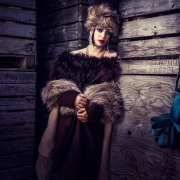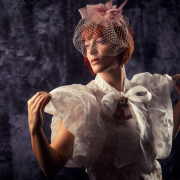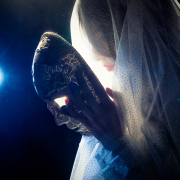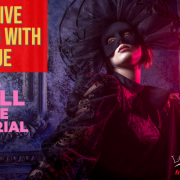Extra note on calibrating lightmeters
Something a lot of people struggle with when calibrating the light meter is the calibration… on this blog I have a special selection on light meters (check it out :-)).
When I teach my students to calibrate the meter to the camera I always use an 18% gray card and shoot this in a as flat as possible light situation and make sure that in the workflow I use the values for this card are 128.128.128
Here is where the confusion starts.
Some cameras are calibrated different, cameras use reflective metering and are set in values between 12-18% gray. Meaning that some cameras will yield different exposures, which can be compensated. A lot of this has to do with the gamma curves and different colorspaces. For example when we look at LAB a gamma curve of around 2.47 will Yield a 128.128.128 value, but mostly gammas of 1.8 and 2.2 are used in colorspaces like sRGB and ProPhotoRGB.
So how do I get to the 128.128.128 values….
Well what you have to remember is that we’re not looking at the way the meter works, the camera works etc. We’re trying to get perfect exposures for the workflow we are using. In other words in MY opinion when I shoot an 18% graycard with my meter, in my workflow, in the colorspace I use, the values should be rendered as 128.128.128
This is all we do while calibrating the meter to the camera/ISO/lens combination.
I’ve used this technique for many years now and get my exposures within perfect every time, when I calibrate to the technical 119.119.119 or even 110.110.110 the exposures are off and I have to use the exposure slider in Photoshop in every shot. in fact that is also not a surprise because we are now not taking into account the settings in our RAW developer, our workflow etc.
It can be incredibly confusing but if we just forget all the technical data and all the voodoo surrounding it, and just look at what should 18% gray be rendered at, I feel that it should be 128.128.128 in my FINAL image.
Seeing the fact that even in that aspect there is a huge difference in opinions only shows how open for discussion this topic can be, I always tell people “do what works for you” for me making sure the 18% gray card renders 128.128.128 in my FINAL image makes my exposures spot on in every situation.
If you like what we do here, and want to support the blog please buy from our affiliate companies by following the links or the links below.

Want to be inspired by the best, make sure to get a subscription to Kelbytraining via this link?
Even the pros get their inspiration from them 🙂






Nice Frank :-).
But exatly how do you do it tecnichally?
Hi Stefan,
It is under the “Light Meter” section of Frank’s blog. The article you are looking for is here: https://frankdoorhof.com/web/2011/08/calibrating-the-light-meter-some-quick-notes/#more-2955
Where can I find 128.128.128 in Photoshop? Could you help me?
128.128.128 is an RGB value 🙂 this is the standard gray, guys some basic image processing knowlage would help much for you.
I do enjoy your blog Mr. Doorhof but there is one thing that is bothering me; it is your use of the word “calibration”. What you are describing is profiling not calibration.
When you calibrate something you take a standard, know input and adjust the equipment to give you the same reading out. The adjustments are done at the hardware or (these days more and more) at the firmware level.
Having worked with equipment that required calibration every year and all the paperwork and tamper indicator stickers that went with it, it is difficult to use the term wrong. Using the word incorrectly meant having everything re-certified and no work until it was.
Rant is over and I feel better. Keep up the great work Frank.
Depends.
Calibration can be used I think. Profiling also. You are in fact taking known values and making sure that those values work after the calibration profiling.
See it as an ISF calibration for your tv/projector. There you also calibrate the whole chain without hardware changes to the start values.
I do know what you mean by the way 😉 but I think calibration can be used in both ways, just like profiling could be used for an ISF calibration.
Very helpul. Thanks for the post. Frank also mentioned to calibrate/profile based on your workflow. Do not zero the default values in your raw converter.
Hello Frank,
I really like your work and I appreciate the fact that you to share your experience with other photographers.Technically speaking however, I do not agree with your opinion of what should be 18% grey as measured in your FINAL image…
You aim at 128-128-128 in your final image, but that would be only correct if your working space is eci-RGBv2 or any other L* based color space.
Most photographers use Adobe-RGB with a 2,2 gamma and my guess is that you also work in Adobe-RGB!
If you read Cie-Lab values in Photoshop you will see that the corresponding lightness in Adobe-RGB is RGB 118-118-118 and NOT 128-128-128.
If your working space is ProPhoto-RGB however this exact grey patch should be 100-100-100 for the SAME lightness, and the exact same “look and feel” of the image.
On the medium gray patches on a colorchecker-SG as wel as on the Kodak 18% grey card the measured L- value is definitely L=50, so in my opinion this should be the same L-value when this grey-patch is measured in the final image.
For a 2,2 gamma workspace RGB 128-128-128 is simply a little bit to light.
If you need to calibrate your lightmeter to RGB 128-128-128 to achieve YOUR perfect lighting in your images, no problem!
I can imagine that you prefer your images with slightly lighter midtones.
But when accurately measured with a spectrophotometer it’s not entirely correct.
John Tromp
studiotromp.nl
I actually don’t want to go into that discussion “again”
You are right if you go from the way of technical view, however…. when looking as photographer in the WORKFLOW, meaning taking EVERYTHING into account, so not working with flat and gamma that still has to be added later, in other words in a color space workflow where everything is already into place I strongly believe that the patch from 18% gray should be in the center of the histogram.
IF I calibrate my meter to 100-100-100 like you say (I use ProPhoto I’m having serious exposure problems, when I set them at 128-128-128 it’s perfect.
Do remember (and this is where this goes wrong for a lot of people) that we are calibrating in the workflow, so not from a JPG or TIFF like the Sekonic software, but straight from the RAW into the RAW convertor. Plus we already have the target.
Let’s look at it this way.
IF you open up a file and you shoot something that should read 100.140.90 you should calibrate it so that in your workflow this opens up as 100.140.90 and not something else.
18% gray is in the END product middle gray, so when you open the file AFTER the RAW convertor and you look IN PHOTOSHOP the patch should LOOK 18% gray and this is exactly the point where I tell people to calibrate, in the software you START editing.
My question…
Do you use a meter and did you try it yourself ?
If so at what point did you do the calibration ?
After the file was open in Photoshop ?
When I calibrate my meter with the Leaf Aptus I’m normally having a deviation of 1/10-2/10 stop when I calibrate to 128.
When I shoot something that’s very close on the edge, like a bright white shirt I will get a perfect exposure on the calibrated setting with just not blowing out peak whites, when I calibrate to all other settings I will not get the exposure I expect.
In reality I never ever touch the exposure slider.
What I do have to add is that when I read a lot of the discussions on forums people are talking about CREATING an 18% gray patch, and in that case you should take a lot into account, I look at it from another viewpoint, and if it’s wrong that’s ok as long as it get’s me perfect exposures (but that it can’t be wrong to be honest), what I do with calibrating the meter is not creating the 18% patch, I already have one, and the only thing I want is that THAT patch is rendered the correct way.
If I would calibrate different for different colorspaces it would make no sense, when I for example work in Prophoto RGB and convert to sRGB my gray should shift, but in reality it doesn’t. In fact when I shoot my 18% gray patch with the calibrated meter and I open it in PS in sRGB and ARGB and ProPhotoRGB they all look the same. As it supposed to be of course. You meter light hitting your model/subject and that should be correct exposure in RAW, when opened in Photoshop you make the decision which color space you choose and that’s why I calibrate in the RAW convertor and not opened up in Photoshop, I calibrate the patch in the RAW convertor, after THAT you tell Photoshop which colorspace to work in and PS does the rest, when it’s opened I will not look at the numbers anymore.
If you shoot a Kodak 18% reflective grey-card and you finally measure in Photoshop: 128-128-128 in Prophoto-RGB you are 22% off and NOT “spot-on”.
You wrote:
>”Let’s look at it this way.
IF you open up a file and you shoot something that should read 100.140.90 you should calibrate it so that in your workflow this opens up as 100.140.90 and not something else.”<
Well that's just my point! here you say it yourself….
This means that if the original subject has a lightness of L50 than this should be the same in the final image.
Since L50 a-0 b-0 is RGB 110-110-110 in Prophoto-RGB and RGB 118-118-118 in Adobe-RGB, in BOTH cases 128-128-128 is just wrong!
OK, if you've discovered through the years that in YOUR workflow and YOUR way of lighting a measured value in the FINAL image should be 128-128-128 for the look and feel that you want, no problem.
But please don't state that 128-128-128 in Prophoto-RGB is the same lightness as the 18% reflective grey-card because it's not!
Yes you are right that 128-128-128 is in the middle of your histogram, but it does NOT represent 18% reflective grey, since that is L=50 and in your case it's L=61.
a 22% difference!
You should know that, because you own an eye-one spectrophotometer and software to measure that yourself.
So in my opinion you found a way of measuring wich gives you just the "right look and feel" that you want in your images.
In order to accomplish that you actually "fool" your lightmeter….
That said I have to admit that if you shoot 3D subjects like fashion models 100% colorimetrically correct, this results in very dull and lifeless pictures!
So for this reason most camera's and RAW convertors use S-curves for more pleasing 3D images.
We therefore don't care about reallity but work towards more pleasing images.
Please don't get me wrong: I don't say that you do it all wrong. Off course not! You have proven that for many years with thousands of great images.
The only thing I disagree with you is the science behind it….
Best regards,
John Tromp
studiotromp.nl
BTW:
Doing things successfully for many years does not automatically mean that you are always right.
If that would be true, I probably win this discussiont just because I already started shooting digitally in 1993.
Sorry Frank, I forgot to answer your question…
>So my question…
Did you try it yourself ?
If so at what point did you do the calibration ?
After the file was open in Photoshop ?<
Yes, but then the midtones are 22% off…
I do a lot of productshots and some customers are very keen on the right color and density of their branding and logo in print.
Often I actually measure the colors on the product with a spectrophotometer in Cie-Lab just to make sure that its as close as possible in CMYK.
I still believe that when something works flawless and any other way doesn’t it’s the way you should use it.
I never claimed anywhere that it’s the same as lab.
I only say that in your raw convertor you need to have it at 128.128.128.
As mentioned before when I calibrate it this way and I meter the model looks flawless in skinbrightness, the whites in the clothing are right there at the 250 point etc.
In the end I don’t care if in LAB mode it’s different, what I do know is that if I calibrate it different than 128.128.128 I need to adjust.
And that’s got nothing to do with personal taste, it’s about being correct with exposure yes or no.
I also never claimed that in colorspace X 128.128.128 would be correct, I don’t care about the colorspace, I open the RAW convertor and THERE I do the calibration, as far as I know it’s at THAT moment still camera RAW and not Prophoto or sRGB or aRGB, when you press OPEN file that’s when it’s openend and changed.
For example in capture one, where there is a colorspace assigned it’s a different value, but that’s not my RAW convertor so I won’t use that one for the calibration.
In Photoshop the 128.128.128 for 18% gray gives me perfect exposure and in the end that counts.
And when someone says I should use 100-100-100 and I try that and it’s way off and also my students/people online claim the same thing I don’t think it’s wrong from me to teach people to do the calibration to 128.128.128.
When looking at LAB and colorspace it could be different and it is, mainly due to the gamma, however again do remember that I do the calibration before the colorspace is assigned.
Thanks for your response and the interesting discussion.
I avoid the gamma issue by working (and measuring) in an L-star based RGB color space.
I use eci-RGBv2 and/or Pro-star RGB. eci-RGBv2 is designed for prepress. When my goal is CMYK according to iso-12647 I use mainly eci-RGBv2.Pro-star RGB has the same gamut as Prophoto-RGB but without the 1,8 gamma curve.In Photoshop I hardly look at the RGB-values. I use the Lab-info as second readout (instead of the standard CMYK-readout). This is because Lab readings represent the actual lightness and color, regardless of the RGB-color space and gamma.In LEAF-capture therefore I use the Lab-readout instead of RGB.
In most other RAW convertors that’s not possible.Anyway, any workflow that provides a constant and predictable result is fine for its user.One of the nice things in photography is that we are often so very different in style, taste and workflow!Keep up your good work!Best regardsJohn Tromp
Interesting indeed, especially because it’s a tricky subject.
One way when I follow my training as technician I’m 100% in your camp, and calculating it, however when looking at the END result I started to doubt, m exposure were just way off.
When I thought about it I concluded that if you wanted to have the biggest chance of doing it right it would be necessary to calibrate it as pure as possible, meaning as soon as it’s out of the camera.
When I choose the RAW convertor of my workflow, in my case Photoshop it all added up, after the opening of the RAW file you make the selection of the colorspace and the conversion is done.
VERY tricky stuff because you will quickly find out that if for example I do the same thing in Capture One I’m ending up with a 10 points difference.
Both are on flat. (well whatever that means because I strongly believe both are NOT flat, although I can’t see any settings that are different.
What I think is going on (and where the problem with this kind of discussions lies) is that I think Capture One is already calculating towards a colorspace and Photoshop not ?
But as you said, repeatability is key 😀
Frank,
Thank you for all the fantastic information. What would be the process for using a meter in ambient light and nothing else. this is probably dumb but what will i be actually metering for? Is this where it would be great to have the more expensive meter and could then make the backgrounds underexposed or do i need lights for that?